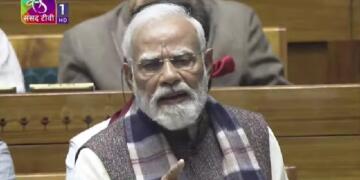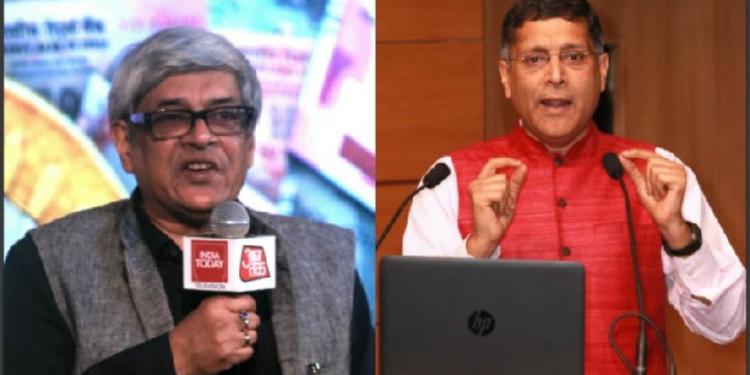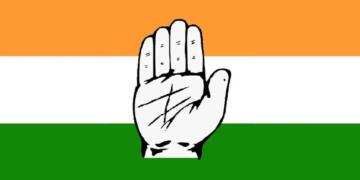The Prime Minister’s Economic Advisory Council has published a paper rebutting former Chief Economic Advisor to the Ministry of Finance, Arvind Subramanian’s paper which claimed that India’s GDP is overestimated by 2.5 per cent. The paper, authored by renowned economists Bibek Debroy, Rathin Roy, Surjit Bhalla, Charan Singh, and Arvind Virmani, mentions that Arvind Subramanian’s paper, which is not peer-reviewed, will not stand the litmus test once experts weigh in on the quality of data and techniques employed in the paper. Nonetheless, the economists expressed that Subramanian’s paper should not be binned, but it also should not be received as the “gospel truth”. “It would only be fair to carefully read the author’s paper without casting aspersions on his integrity or motives”, the paper says while the authors resort to nothing less than a detailed point by point rebuttal to Arvind Subramanian’s claims of GDP overestimation, perhaps to settle the dust once and for all.
The paper begins with what can be read as an address to the novice inspired confusion about the Central Statistics Office, CSO’s revised methodology of GDP calculation which was adopted in 2015. “The process of changing the GDP estimation methodology started in 2008 with the Advisory Committee on National Account Statistics forming 5 subcommittees.” says the paper, one of the outcomes being Incorporation of the Recommendations of System of National Accounts (SNA), 2008. These changes provide better insight into the realities of India’s GDP and are not an overestimation of the same. It mentions that other countries have switched their GDP calculation methodologies as well based on SNA, 2008 and that India would have been an outlier if it had not done the same. This switch led to increases in GDP in some OECD countries, reductions in others but in no case is the methodology flawed compared to the previous one.
“Having closely read the paper and taking into account all information available until 19th June 2019, the primary contributors of this note reject the author’s methodology, arguments and conclusions in the said paper. A critique of official GDP estimates must specifically critique coverage or methodology, the author does neither. The author mentions that the motivation of his paper is not political and is focused on technical aspects. However, given the fact that his paper lacks rigor in terms of specific data sources and description; alternative hypothesis; rationale of equation specifications, use of dummies, and robustness-check diagnostics of estimated equations; and choice of countries in the sample and a specific list; it would not stand the scrutiny of academic or policy research standards.”
The paper goes on to say that Arvind Subramanian cherry-picked indicators to establish potential flaws in the growth rate post 2011-12. Pointing out that the majority of the 17 indicators were taken directly from Center for Monitoring Indian Economy (CMIE), a private agency that is not a primary source of information and that it is conceptually incorrect to relate levels of GDP to levels of indicators as the national income accounting framework estimates value addition of different economic activities, and not merely changes in indicators of these activities. Further, Arvind Subramanian seems to have passed on the selected indicators as strongly correlated with GDP without substantiating the claim and ignoring indicators from the Services and agriculture sector which account for 60 per cent and 18 per cent of the GDP respectively.
The authors also mention that Arvind Subramanian questionably chose to overlook tax data claiming that tax indicators were unemployable because of major changes in direct and indirect taxes in the post-2011 period and this claim does not hold water as the authors explain:
“Unlike many indicators, tax data is not collected through surveys or by agencies through arcane techniques, these are hard numbers and should be an important indicator of growth. Further, there have been no major changes in tax laws until the end period in the author’s analysis (31st March 2017). GST was introduced on 1st July 2017. The author’s logic of not using tax data appears to be a convenient argument meant to avoid inconvenient conclusions based on hard facts.”
The paper suggests that among Subramanian’s cherry-picked indicators, the data may be right but the calculations and conclusions are wrong, impulsive and conveniently maneuver around other more likely possibilities. It also calls his attempt at evaluating the extent of over-estimation “An unusual econometric exercise with unworthy results” where he chooses only 4 of the 17 indicators again ignoring the Services and Agriculture sector which together make up for 78 per cent of the GDP.
On the cross-country regression where Subramanian compared India to the performance of 70 other countries the paper says that Subramanian “neglects or assumes productivity growth differences to be constant across countries, which is inadequate in a growth regression, and unfair to India whose productivity growth differential was rising in this period [post 2011]”. “The paper uses 70 countries as control and only one country (India) as treatment, something that is bad econometrics.” Consequently, both the 2.5% GDP overestimation and its confidence interval are highly suspect. Also, the data frame used by the author (15 years: 10 years pre2011, and 5 years post-2011) appears to be too small to draw statistical inferences about India’s GDP trends.” and that “when variables are growing, a regression in levels can give spurious results.”
The authors go on to point out Arvind Subramanian ‘s clear institutional bias against the CSO while blindly trusting the CMIE, “He explicitly states that one of the reasons for his choice of 17 indicators is that CSO doesn’t produce them.” Such a precedent is unwarranted for a neutral academic, says the paper.
Furthermore, on Arvind Subramanian ‘s belief that 2004-05 series was perfect, and all the calculation and estimation errors only happened post 2011, the authors questioned, “If everything was perfect before 2011, why did global experts encourage India to adopt a more robust GDP calculation methodology?” and reiterated that Subramanian’s paper would not pass the smell test.
Finally, the paper says, ” If anything, the weakness of Dr. Subramanian’s attempt to suggest that the growth numbers are over-estimated confirms that the estimation process is robust to spurious criticism.” India’s GDP calculation methodology is in line with internationally accepted standards and evolving towards betterment, and that is something to be relieved about. Further, the paper mentions that Dr. Arvind Subramanian, having had occupied the esteemed post of the Chief Economic Advisor to the Finance Ministry overlooking an army of hardworking government economists and statisticians in a complex continent-sized country like India, demoralizes the same lot by using simplistic tools and cherry-picked indicators to make sensational claims.






























